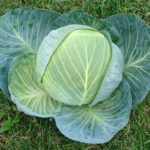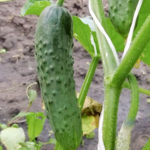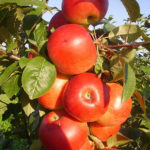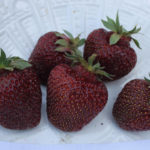Rosa hocus pocus (Hocus pocus)
Striped roses look bright, intriguing and very stylish. But nature alone could not create such a masterpiece worthy of admiration. Breeders came to her aid. This creative union delighted gardeners with roses with unusual colors and ideal shapes. One of these amazing varieties and the name is funny - Hocus pocus, or Hocus pocus. Hokus Pocus would be more correct, of course, but the second pronunciation is more familiar to our ears.
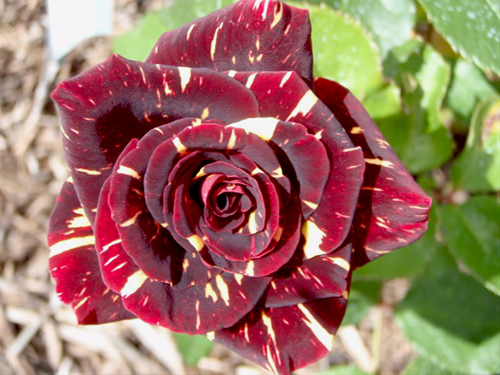
History of creation
Our hero was born thanks to the breeders of the German company W. Kordes & sons (Kordes), which is quite famous in Russia. The original variety was a variety also belonging to the selection of Cordes - Black Beauty. The new rose was introduced in 2000. In the flower market, it is known as Hocus pocus Kordana. The unique letter code is KORpocus. Opinions on determining whether a new item belongs to a particular variety differ among many rose growers. Some consider the Hocus Pocus to be a representative of the hybrid tea family, while others classify it as a floribunda. The variety was conceived as a cutting variety, but the location of the side stems makes the cutting procedure inconvenient, and the peduncle is short.
Description
The bush is small and neat. The height of the plant is 50 - 60 cm, sometimes, if the rose grows in the shade, it can grow up to 80 cm, it does not take up much space in diameter, only 40 cm. The bush is quite branchy and leafy. Shoots are upright, strong enough, thorns are practically absent. The leaves are rather large, pinnate, dark green, the surface is smooth, glossy. Mainly one bud is formed on each stem. But sometimes the bush shoots out small multi-colored inflorescences of 3 - 5 pieces. During flowering on a small plant, up to 15 roses can bloom at the same time. The productivity of Hocus Pocus is high - 220 - 250 flowers per 1 square meter per year.

The bud is small, very elegant, dense. The flower is small in size - 6 - 7 cm. It consists of 30 - 40 petals, therefore it belongs to terry. In a complete dissolution, the middle is practically not visible. The petals are velvety to the touch; at the stage of opening, the edges are strongly bent back, which is why sharp tops are formed. But closer to the center, the petals have a softer and smoother curve. The usual color of the Hocus pocus flower is very original. The main color of the rose petals is rich, burgundy-wine-red. Irregular yellow stripes with clear edges, thin stripes or spots of the same color make a bright contrast to the main background. All this adds up to a complex configuration. As a result, the pattern on each petal is unique, but what are the petals, it is impossible to meet flowers with the same pattern. But it's not for nothing that the variety was called Focus Pokus. Sometimes the bush, as if by magic, instead of colorful flowers, presents the rose grower with an armful of yellow or burgundy flowers.
Bloom
Our hero belongs to the re-flowering species. It blooms at the end of May and blooms throughout the season, until the very cold weather. In warm regions, for example, in the Krasnodar Territory or Crimea, flowering can continue until the end of November (of course, if the autumn is warm). The breaks between the abundant flower waves are practically invisible, so some growers claim that the bushes bloom without interruption. The flowers last for a long time, about 2 weeks. Faded heads must be removed in a timely manner so that the plant does not waste energy on them. But if, looking at the color extravaganza, you expect the same bright aroma, then you are mistaken. The smell of a rose is light and unobtrusive, barely perceptible.

Characteristics
- Focus Pocus blooms in the second year after planting;
- frost resistance is above average. The variety is recommended for cultivation in USDA zone 6 according to the system developed by the US Department of Agriculture. This suggests that the plant can winter at -20.6 ° C ... -23.3 ° C without shelter. But if the winter period is accompanied by either thaws or a sharp drop in temperature, it is worth taking care of the shelter;
- Hocus pocus has average immunity.Resistance to powdery mildew is relatively high. Culture suffers from black spot more often. But, in general, many growers talk about the high resistance of the variety to diseases;
- of insects, the rose is most worried about by aphids;
- poor resistance to rain. During the rainy season, the buds may not open;
- in hot regions, with increased solar activity, the flower dries up prematurely;
- cut flowers Hocus pocus keep in a vase for a long time - up to 16 days.
Planting and leaving
It is best to plant Hocus pocus seedlings in the spring. If an autumn planting is supposed, then it should be carried out 3 weeks before the onset of a stable cold snap. The culture prefers fertile, moisture and air permeable soils. The groundwater level should not be higher than the meter mark. It is advisable to set aside a well-lit place for landing. But in hot regions, the midday sun can be very harmful, so it is advisable to plant a rose so that during this period there is a slight partial shade over the plant.
The care is not fancy, it fits well into the standard procedures. Watering is carried out as needed, but if it is too hot outside, excess moisture will not be superfluous. In the spring, the rose is fertilized with nitrogen to stimulate the rapid growth of the green mass. During the flowering period, phosphorus and potassium are needed. If the plant is left without feeding, the flowers will begin to shrink. Pruning is carried out in early spring, before the buds awaken. For the winter, you can cover the trunk circle with peat, and the bush with spruce branches.
Hocus Pocus is a real lottery. You never know what colors she will play in the next season. But definitely, the variety is very interesting and certainly not boring. It is easy to look after him. But from pests and diseases, the rose must be processed. Of the minuses, the plant's poor resistance to prolonged rains can be called. In addition, many gardeners complain that the culture often returns to its parental coloration, that is, it becomes similar to Black Beauty. Although the originators insist that rebirth is impossible. Many gardeners use a short plant as a decorative border. The culture looks good in single plantings. But to combine it with other flowering plants is extremely difficult. True, if you choose green spaces as the background for the Focus Pokus, then you certainly won't go wrong.
